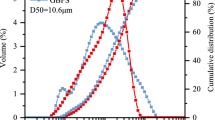Abstract
The objective of this study was to assess the feasibility of utilization of grinding aids (GA) in the granulated blast furnace slag (GBFS) powder production. The GBFS powders were prepared with different GA, and their grindabilities, fluidities, reactivities and hydration characteristics were investigated. The experimental results indicate that although the improvement scales are various, all GA are very effective to explore the GBFS grindability. The energy can be accordingly reserved to grind the GBFS to specified specific surface area. GA with TIPA notably enhances the GBFS powder fluidity. The reactivity increment of GBFS powder at different hydration age is strongly related to the GA type and content. GA with TIPA has the more remarkable influences on fluidity, reactivity and CH content than GA with TEA. Composite use of TEA and TIPA is more favorable to the improvements of some GBFS properties such as grindability and fluidity. Besides, hardened mixtures with GA are provided with denser microstructures than that of control. GA application is an optional technology with lower energy consumption to produce GBFS powder, whilst the GBFS powders display the higher reactivity and better fluidity.




Similar content being viewed by others
References
Swamy RN (1986) Cement replacement materials concrete technology and design, vol 3. Surry University Press, London
Escalante JI, Gomez LY, Johal KK, Mendoza G, Mancha H, Mendez J (2010) Reactivity of blast furnace slag in Portland cement blends hydrated under different conditions. Cem Concr Res 31:1403–1409
Bentz DP (2006) Influence of water–cement ratio on hydration kinetics simple models based on spatial considerations. Cem Concr Res 36:238–244
Mazloom M, Ramezanianpour AA, Brooks JJ (2004) Effect of silica fume on mechanical properties of high-strength concrete. Cem Concr Compos 26:347–357
Bensted J, Barnes P (2002) Structure and performance of cements, Sencond edn. Spon press, Ludon
Geiseler J, Kollo H, Lang E (1995) Influence of blast-furnace cements on durability of concrete structures. ACI Mater J 92(3):252–257
Osborne GJ (1999) Durability of Portland blast-furnace slag cement concrete. Cem Concr Compos 21:11–21
Lawrence P, Cyr M, Ringot E (2005) Mineral admixtures in mortars effect of type, amount and fineness of fine constituents on compressive strength. Cem Concr Res 35:1092–1105
Cyr M, Lawrence P, Ringot E (2006) Efficiency of mineral admixtures in mortars: quantification of the physical and chemical effects of fine admixtures in relation with compressive strength. Cem Concr Res 36:264–277
Demirboga R, Turkmen I, Karakoc MB (2004) Relationship between ultrasonic velocity and compressive strength for high volume mineral admixtured concrete. Cem Concr Res 34:2329–2336
Johansen V, Andersen PJ (1989) Particle packing and concrete properties. In: Mindess S (ed) Skalny J. The American Ceramic Society Inc, Materials science of concrete II, pp 111–148
Seebach MV, Schneider L (1986) Update on finish grinding with improved energy efficiency. World Cem 17(8):336–346
Worrel E, Martin N, Price L (2000) Potentials for energy efficiency improvement in the US cement industry. Energy 25:1189–1214
Jankovic A, Valery W, Davis E (2004) Cement grinding optimization. Miner Eng 17(11–12):1075–1081
Sohoni S, Sridhar R, Mandal G (1991) The effect of grinding aids on the fine grinding of limestone, quartz and Portland cement clinker. Powder Technol 67(3):277–286
Bathia JS (1979) Use of grinding aids in ball mill grinding. World Cem Technol 10(10):413–417
Magistri M, Presti AL (2007) Influence of grinding aids. World Cem 38(6):39–41
Teoreanu I, Guslicov G (1999) Mechanisms and effects of additives from the dihydroxy-compound class on Portland cement grinding. Cem Concr Res 29:9–15
Rajendran Nair PB, Paramasivam R (1999) An analysis of the influence of grinding aids on the breakage process of calcite in media mills. Adv Powder Technol 10(3):223–243
Dodson VH (ed) (1990) Concrete admixtures. Van Nostrand Reinhold, New York
Yilmaz VT, Menek N, Odabasoglu M (1993) Quantitative determination of triethanolamine in cements. Cem Concr Res 23(3):603–608
Gartner E, Yers D (1993) Influence of tertiary alkanolamines on Portland cement hydration. J Am Ceram Soc 76(6):1521–1530
Katsioti M, Tsakiridis PE, Giannatos P (2009) Characterization of various cement grinding aids and their impact on gindability and cement performance. Constr Build Mater 23(5):1954–1959
Jeknavorian AA, Barry EF, Serafin F (1998) Determination of grinding aids in Portland cement by pyrolysis gas chromatography-mass spectrometry. Cem Concr Res 28(9):1335–1345
Choi H, Lee W, Kim S (2009) Effect of grinding aids on the kinetics of fine grinding energy consumed of calcite powders by a stirred ball mill. Adv Powder Technol 20(4):350–354
Albayrak AT, Yasar M (2005) Investigation of the effects of fatty acids on the compressive strength of the concrete and the grindability of the cement. Cem Concr Res 35:400–404
Zhu X, Hou HB, Huang XQ, Zhou M, Wang WX (2012) Enhance hydration properties of steel slag using grinding aids by mechanochemical effect. Constr Build Mater 29:476–481
Kyle R, Silva DA, Scrivener K (2010) Early age strength enhancement of blended cement systems by CaCl2 and diethanol-isopropanolamine. Cem Concr Res 40:935–946
Cheung J, Jeknavorian A, Roberts L, Silva D (2011) Impact of admixtures on the hydration kinetics of Portland cement. Cem Concr Res 41:1289–1309
Heren Z, Olmez H (1996) The influence of ethanolamines on the hydration and mechanical properties of Portland cement. Cem Concr Res 26(5):701–705
Wang Q, Yan PY (2010) Hydration properties of basic oxygen furnace steel slag. Constr Build Mater 24:1134–1140
Acknowledgments
Thanks to National Basic Research Program of China (973 Program: 2011CB013805), National Natural Science Foundation of China (51302189, 51308406 and 51102182) and National Key Project of Scientific and Technical Supporting Programs of China (No. 2014BAL03B02) for their financial supports for these projects.
Author information
Authors and Affiliations
Corresponding author
Rights and permissions
About this article
Cite this article
Li, H., Yang, X., Jiang, Z. et al. Effect of different grinding aids on property of granulated blast furnace slag powder. Mater Struct 48, 3885–3893 (2015). https://doi.org/10.1617/s11527-014-0450-0
Received:
Accepted:
Published:
Issue Date:
DOI: https://doi.org/10.1617/s11527-014-0450-0




